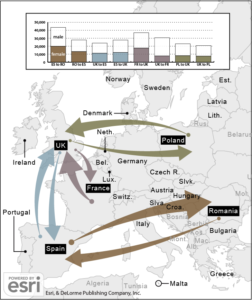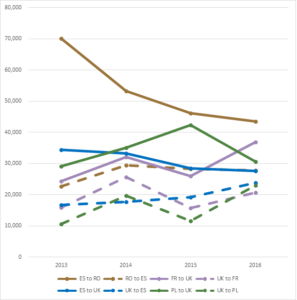Largest Bilateral Migration Corridors Within the EU28
May 7, 2019
By Zachary Strain and Katrin Marchand
This is the second in a series of blogs exploring major trends in intra-EU migration patterns. Read the previous blog here. More information about the research is available here.
In continuation of our blog series on intra-EU migration, in this post we will dive deeper into the largest bilateral (country-to-country) flow corridors—that is, the pairs of EU28 countries between which we see the largest migration flows—and explore the implications of this data with regards to circular migration.
Within the EU28, certain countries are frequently perceived as ‘destination’ countries, i.e., as experiencing high levels of immigration, while others are seen as ‘source’ countries – that is, as experiencing high levels of emigration. Conversations around migration often focus on either source (a.k.a. sending, origin) or destination (a.k.a. receiving, host) countries, but less often discuss when two countries are (strongly) linked by migration flows within bilateral corridors.
Evidence of these bilateral corridors can be seen using Eurostat data on a migrant’s country of previous residence and country of next residence. Among the 20 largest country-to-country flows in 2016, based on the countries of previous and next residence metric, eight can be characterized as bilateral corridors, namely, between Spain and Romania, France and the UK, Spain and the UK, and Poland and the UK (see Figure 1). Along with the data on the absolute number of migrants, there is also data on gender (but rarely on age).

Figure 1: Major EU28 bilateral migration flow corridors, based on country of previous and next residence (2016)
In the case of the Spain-Romania corridor, this has consistently been the busiest corridor over the period 2013 to 2016 (see Figure 2). In each year, flows from Spain to Romania have been among the largest country-to-country flows, as have those from Romania to Spain, albeit to a lesser degree. However, the former has declined considerably, falling from 70,055 in 2013 to 43,509 in 2016. Flows from Romania to Spain have increased overall in the same period, but do not follow a consistent pattern of growth or decline.
Looking at demographic characteristics within this corridor, migrants are typically young adults and male. When disaggregating by age, there is only data available for the Romania to Spain direction. For 2016 flows, the 20-29 year-old age cohort was the largest, while the 65+ one was the smallest. Disaggregating by sex, migrants in both directions were more likely to be male, though to a greater degree in the direction of Romania.
The UK-France corridor was the second largest bilateral corridor in 2016, with more movers in the direction of the UK. The balance of sexes differs between the two flow directions: approximately even in the direction of the UK, while females make up just one third of the flows in the other direction, to France. There is no age disaggregation available. In the 2013 to 2016 period, this corridor remained in the top 15 country-to-country flow corridors. The flows to the UK have always been higher than those to France during this period as well.
The third largest country-to-country flow corridor in 2016 was between Poland and the UK. Unfortunately, there is no age disaggregation data for these flows, in either direction. Of the top country-to-country flow corridors discussed in this blog, this one has the greatest sex imbalance in both directions. Nearly three fourths of the flows to Poland are men (which is also the larger flow direction), while about two thirds are men in the direction of the UK. While the Poland to UK flow corridor was consistently amongst the top country-to-country flow corridors between 2013 and 2016, flows in the opposite direction were not as consistently high, failing to appear in the top 20 in 2013 and 2015.
Lastly, there is the Spain-UK corridor, which was the most directionally balanced of the corridors discussed in this blog for the year 2016, with only 2,802 more movers in the direction of the UK than Spain. Males make up a relatively larger share of movers in the direction of the UK than toward Spain. While there is no age data for Spain to the UK, for the UK to Spain, we see that the largest cohort is the 35-64 age cohort, and the 15-19 is the smallest. During the 2013 to 2016 period, the UK consistently saw more arrivals than Spain did year-to-year. This bilateral corridor was also amongst the top country-to-country flow corridors for the period as well.

Figure 2: Yearly flows between top bilateral corridors, 2013-2016
While the volumes of flow in both directions is relatively high for each bilateral corridor, that does not necessarily mean that the exchange of citizens between these countries is balanced. So far, we’ve only looked at bilateral flows in terms of the countries of previous and next residence. Therefore, we need to know the stocks of migrants between these bilateral corridors to help flesh out the picture. Consider Figure 3 below:

Figure 3: Stocks of citizens in bilateral corridors, 2016
On the one hand, the foreign citizen stocks are relatively even for both countries in two corridors: Spain and the UK, and France and the UK. Taken with the fact that there are sustained high flows in each direction along these corridors during 2013-2016 (Figure 2), it would seem that there is a relatively balanced flow of citizens between both pairs of countries. Conversely, there is a clear imbalance of exchange of citizens between Poland and the UK, as is also the case for Romania and Spain. This would strongly imply a circulation of citizens from Poland and Romania through the bilateral corridors, or at least return migration.
Importantly, this is some of the stronger evidence of circular migration currently available. As noted in a previous blog, most migration statistics only track a migrant’s latest movement, failing to shed light on repeated or serial movement. The evidence we have reviewed appears to suggest the possibility of serial movements of the same migrants between two countries, but anything beyond that is speculation. One of our key recommendations to data collectors would then be to include questions to serial movements in data gathering, in order to shed light on the trends in this regard.
Zachary Strain is a research consultant at the Maastricht Graduate School of Governance.
Katrin Marchand is a postdoctoral researcher at UNU Merit, based at the Maastricht Graduate School of Governance.
